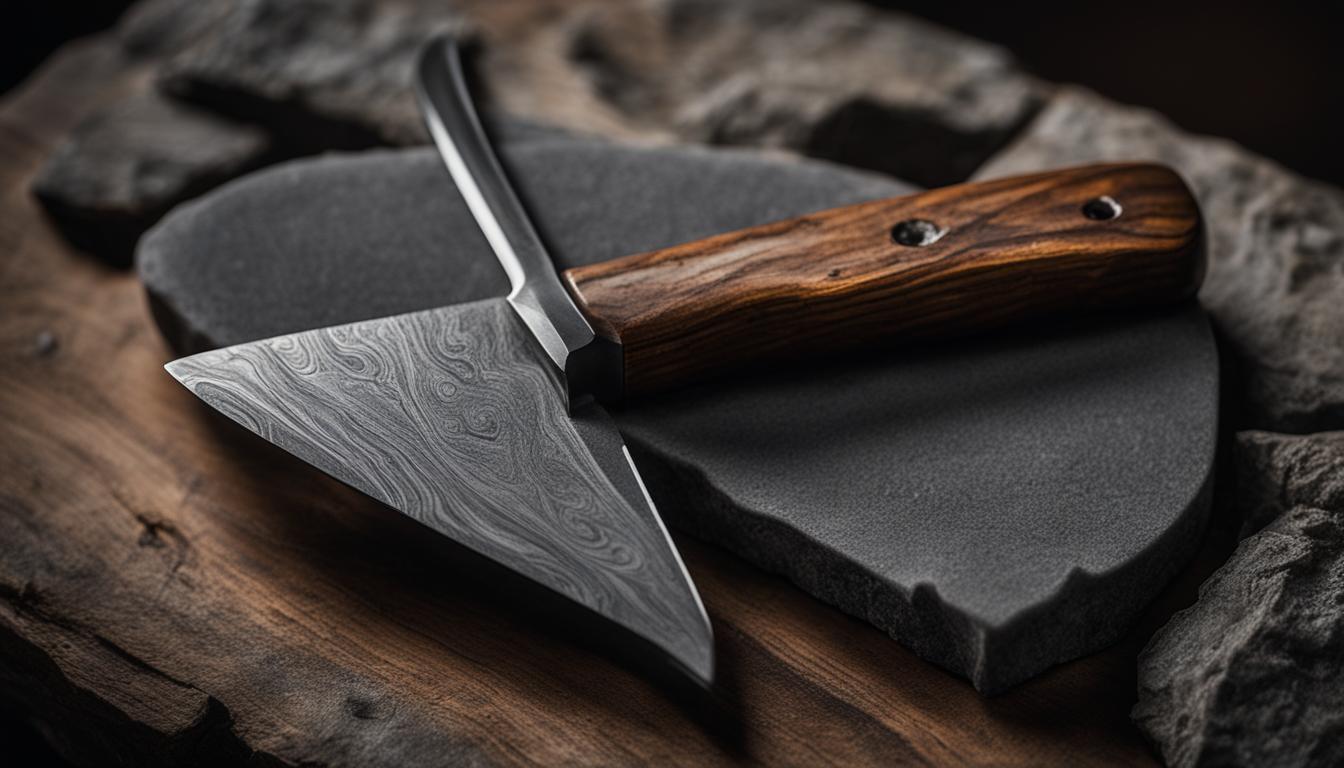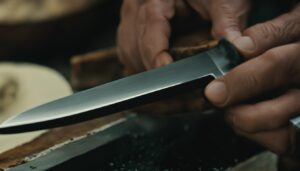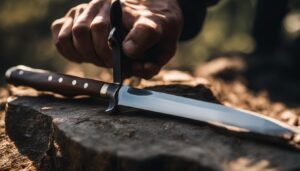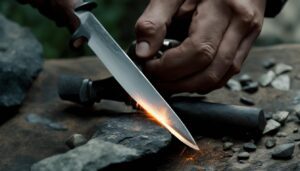When it comes to sharpening your hunting knife, selecting the right grit is crucial. The grit refers to the coarseness or fineness of the sharpening stone and determines how much material will be removed from the knife blade during sharpening. Our comprehensive guide will help you understand the different grit options available and how to choose the best one for your hunting knife.
Key Takeaways:
- Choosing the right grit is vital for sharpening your hunting knife effectively.
- Consider the condition of the blade and your intended use when selecting the grit.
- There are various types of sharpening stones, each with its own advantages and disadvantages.
- Factors such as material type, grit selection, budget, and maintenance requirements should be considered when choosing a sharpening stone.
- Follow best practices for sharpening your hunting knife to achieve optimal results.
Understanding Sharpening Stone Grits
When it comes to knife sharpening, using the right grit is essential to achieve optimal results. Grit refers to the coarseness or fineness of the sharpening stone and plays a crucial role in determining the level of material removal from the knife blade during sharpening. Different grit sizes are available, each serving a specific purpose in the sharpening process.
Coarser grits, typically ranging from 100 to 400, are used for initial sharpening or when dealing with blades that have significant damage or dullness. These grits are effective in removing material quickly and shaping the blade. Medium grits, ranging from 800 to 1500, are commonly used for general sharpening, refining the edge, and removing any remaining scratches or imperfections.
Finer grits, such as 2000 and above, are used for final polishing and honing, resulting in a razor-sharp edge and a mirror-like finish. These high-grit stones excel in refining the blade and achieving a fine level of sharpness. It’s important to note that the progression from coarser to finer grits is crucial for achieving the desired level of sharpness and refinement. Skipping grits or using a grit that is too fine too soon can hinder the sharpening process and limit the effectiveness of the sharpening stone.
Table: Common Grit Sizes and Their Uses
| Grit Range | Common Use |
|---|---|
| 100-400 | Initial sharpening, repairing damaged blades |
| 800-1500 | General sharpening, refining the edge |
| 2000+ | Polishing, honing, achieving a razor-sharp edge |
Using the right grit for knife sharpening is crucial for achieving a sharp and effective blade. Remember to follow the progression from coarser to finer grits, allowing each grit to perform its specific role in the sharpening process. By understanding the different grit sizes and their uses, you can choose the appropriate grit for your knife and ensure a successful sharpening experience.
Choosing the Right Grit for Your Hunting Knife
When it comes to sharpening your hunting knife, selecting the appropriate grit is essential. The grit determines how much material will be removed from the blade during sharpening and plays a significant role in achieving the desired sharpness. To choose the right grit for your hunting knife, consider the current condition of the blade and your intended use.
If your knife blade is damaged or has chips, starting with a coarser grit is recommended. Coarser grits, such as 400 or 600, are effective in repairing and reshaping the edge of the blade. After using a coarse grit, progressively move to finer grits for sharpening and honing.
For general sharpening and maintenance, a medium or medium fine grit, such as 1000 or 2000, is usually sufficient. These grits remove a moderate amount of material and help maintain the knife’s sharpness. If you want to achieve a razor-sharp edge or a mirror-like polish, higher grits, such as 3000 or above, are ideal for the finishing touches.
To meet different sharpening needs and ensure optimal results, it’s recommended to have a range of grits available. A complete sharpening kit may include coarse, medium, medium fine, and fine grits, allowing you to tackle various sharpening tasks effectively. By selecting the appropriate grit and following proper sharpening techniques, you can keep your hunting knife sharp and ready for any adventure.
Table: Recommended Grits for Different Sharpening Purposes
| Purpose | Recommended Grit Range |
|---|---|
| Repairing and reshaping damaged blades | 400-600 |
| General sharpening and maintenance | 1000-2000 |
| Achieving razor-sharp edge or mirror-like polish | 3000 and above |
Choosing the right grit for sharpening your hunting knife is key to maintaining its performance and longevity. Consider the current condition of your blade and the level of sharpness you desire. With the appropriate grit and proper technique, you can keep your hunting knife in optimal condition for your next outdoor adventure.
Types of Sharpening Stones
When it comes to sharpening your hunting knife, using the right type of sharpening stone is essential. There are several options available, each with its own unique characteristics and benefits. Let’s take a closer look at the different types of sharpening stones:
Diamond Stones
Diamond stones are known for their durability and fast-cutting ability. These stones feature a diamond abrasive surface that can quickly remove material from the blade, making them excellent for repairing damaged or dull edges. Diamond stones are also known for their long lifespan, making them a reliable choice for hunters who frequently sharpen their knives.
Water Stones
Water stones, also known as Japanese water stones, are popular among professional chefs and knife enthusiasts for their exceptional sharpening qualities. These stones are made from a combination of abrasive particles bonded with clay. They require soaking in water before use, which helps keep the stone clean and prevents heat buildup during sharpening. Water stones are available in a range of grits, making them suitable for both sharpening and polishing.
Oil Stones
Oil stones are traditional sharpening stones that use oil as a lubricant during the sharpening process. These stones are typically made from natural materials such as Novaculite or Aluminum Oxide. Oil stones are known for their excellent cutting ability and versatility, as they can be used for both coarse and fine sharpening. However, they require regular oiling and cleaning to maintain their performance.
Strops
While not technically a sharpening stone, strops are often used in conjunction with sharpening stones to refine and polish the knife blade. Strops are typically made of leather or other flexible materials and are used to remove any remaining burrs or imperfections, resulting in a razor-sharp edge. They are commonly used by professional sharpeners and knife enthusiasts who want to achieve the highest level of sharpness.
When choosing a sharpening stone for your hunting knife, consider factors such as the desired level of sharpness, the type of blade material, and your personal sharpening preferences. Experimenting with different types of sharpening stones can help you find the one that best suits your needs and helps you maintain a razor-sharp edge on your hunting knife.
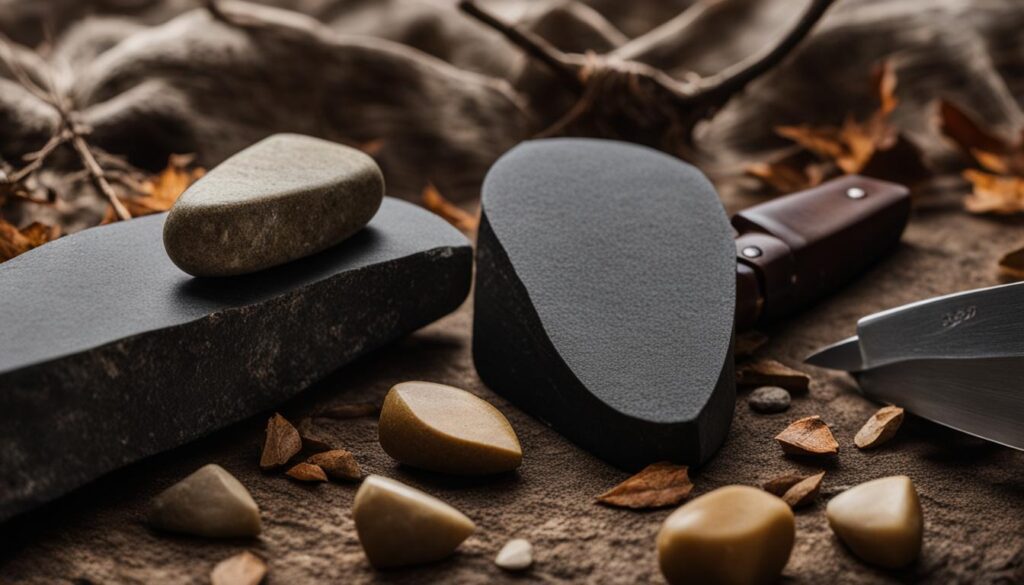
Considerations for Choosing a Sharpening Stone
When it comes to selecting a sharpening stone for your hunting knife, there are several important factors to consider. These considerations will help ensure that you choose a stone that is suitable for your needs and preferences.
Material type
One of the first things to consider is the material type of the sharpening stone. There are various options available, each with its own unique advantages and characteristics. For example:
Diamond stones: Known for their durability and ability to quickly sharpen even the toughest blades.
Water stones: These natural stones provide excellent results and are popular among professional sharpeners.
Oil stones: These stones require lubrication with oil and are known for their versatility and ability to produce a razor-sharp edge.
Strops: While not technically a stone, strops are used for polishing and refining the edge of a blade.
Consider your personal preferences and the specific needs of your hunting knife when choosing the material type of your sharpening stone.
Grit selection
The grit of the sharpening stone is another crucial consideration. Grit refers to the coarseness or fineness of the stone’s surface and determines the level of abrasiveness. Different grits are suitable for different stages of knife sharpening. Some common grit options include:
- Coarse grit (100-400): Ideal for repairing damaged blades and reshaping the edge.
- Medium grit (800-1200): Suitable for general sharpening and maintenance.
- Fine grit (1500-3000): Used for achieving a polished and refined edge.
- Extra fine grit (4000-8000+): Ideal for achieving a mirror-like finish or razor-sharp edge.
Consider the current condition of your hunting knife and the desired sharpness when selecting the appropriate grit for your sharpening stone.
Budget and maintenance requirements
Another factor to consider is your budget and the maintenance requirements of the sharpening stone. Some materials and grits may be more expensive than others, so it’s essential to consider your budget when making a decision. Additionally, certain sharpening stones may require regular flattening or conditioning to maintain their effectiveness.
Take into account your financial constraints and the amount of time and effort you’re willing to invest in maintaining your sharpening stone.
By carefully considering the material type, grit selection, budget, and maintenance requirements, you can choose a sharpening stone that will help you achieve optimal results when sharpening your hunting knife.
| Material Type | Advantages |
|---|---|
| Diamond Stones | Durable and can quickly sharpen tough blades |
| Water Stones | Provide excellent results and popular among professionals |
| Oil Stones | Versatile and produce a razor-sharp edge |
| Strops | Used for polishing and refining the edge |
Best Practices for Sharpening Your Hunting Knife
When it comes to sharpening your hunting knife, following best practices can help you achieve optimal results. Here are some key tips to keep in mind:
1. Selecting the Right Whetstone
Choosing the appropriate whetstone for your hunting knife sharpening is essential. Whetstones come in various grits and materials, such as water stones and oil stones. Consider the current condition of your blade and the sharpening goals you have in mind. Coarser grits are ideal for repairing damaged blades, while finer grits are suitable for achieving a polished, razor-sharp edge.
2. Proper Use of Grinding Oils
Grinding oils can enhance the efficiency and effectiveness of your sharpening process. They help to lubricate the sharpening stone and prevent friction between the blade and the stone. Apply a few drops of grinding oil to the stone before sharpening, and periodically reapply if needed. This will ensure smooth and consistent sharpening results.
3. Understanding Sharpening Angles
An important aspect of knife sharpening is understanding the proper sharpening angle. Different knives require different sharpening angles, depending on their intended use and blade thickness. Generally, hunting knives have a sharpening angle between 20 to 25 degrees. Using a sharpening guide or a sharpening angle tool can assist you in maintaining a consistent angle throughout the sharpening process.
4. Ensuring Blade Alignment
Proper blade alignment is crucial for achieving an even and symmetrical edge. Make sure the blade is aligned with the sharpening stone and maintain a steady hand while sharpening. Keep an eye on the blade’s progress and adjust as needed to ensure an even sharpening across the entire length of the blade.
5. Regular Maintenance of Sharpening Tools
To maintain optimal performance, it’s important to take care of your sharpening tools. Clean your whetstones after each use to remove any metal particles or debris. Store them in a safe and dry place to prevent damage. Additionally, periodically flatten your sharpening stones to ensure a level surface for consistent sharpening results.
By following these best practices, you can sharpen your hunting knife effectively and achieve a sharp and durable edge. Remember to exercise caution and practice proper knife handling techniques throughout the sharpening process for your safety.
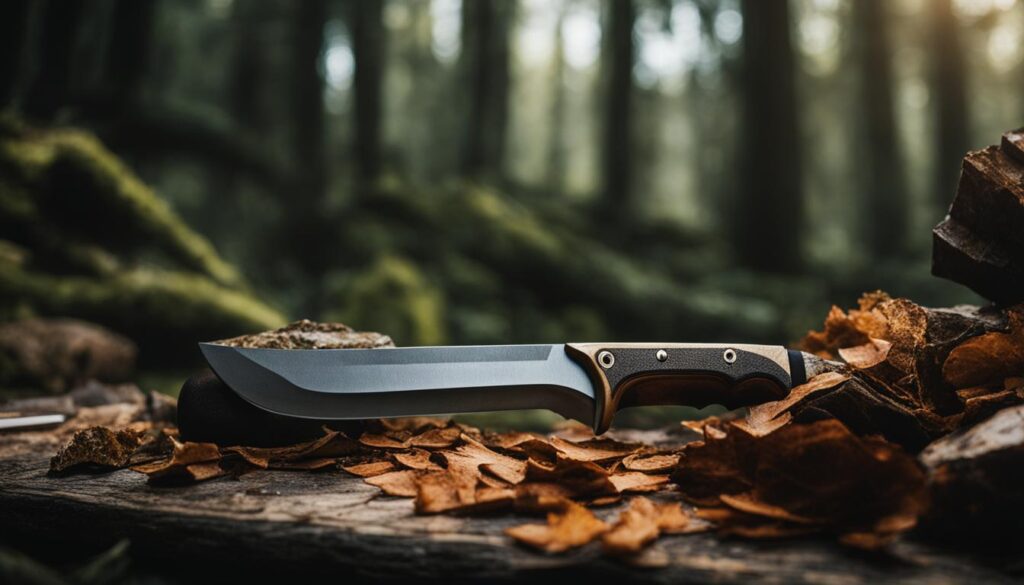

Conclusion
After understanding the different grit options and considering factors such as the current condition of the blade and your intended use, you can confidently choose the right grit for sharpening your hunting knife. The grit you select will play a crucial role in maintaining the sharpness and effectiveness of your knife.
Remember to always use proper sharpening techniques and maintain your sharpening stones for optimal performance. Regularly clean and flatten your stones, and ensure they are properly lubricated if required. This will prolong their lifespan and ensure consistent results.
By following the best practices outlined in this guide and selecting the appropriate grit, you can ensure that your hunting knife is always sharp and ready for use. Whether you need to repair damage, maintain an edge, or achieve a razor-sharp finish, using the right grit will make all the difference. Happy sharpening!
FAQ
What is the importance of selecting the right grit for sharpening my hunting knife?
The right grit determines how much material will be removed from the knife blade and is crucial for achieving the desired level of sharpness.
How do I choose the appropriate grit for my hunting knife?
Consider the current condition of the blade and your intended use. Start with a coarser grit for damaged blades, use medium or medium fine grits for general sharpening, and choose higher grits for achieving razor-sharp edges or mirror polish.
What types of sharpening stones are available?
The main types include diamond stones, water stones, oil stones, and strops, each with its own advantages and disadvantages.
What factors should I consider when choosing a sharpening stone for my hunting knife?
Factors to consider include the material type, grit selection, budget, and maintenance requirements of the sharpening stone.
What are the best practices for sharpening a hunting knife?
Use whetstones, grinding oils, and proper sharpening angles to achieve optimal results. Pay attention to blade alignment and maintain your sharpening stones for optimal performance.
How can I ensure that my hunting knife is always sharp and ready for use?
By choosing the right grit for sharpening, following proper sharpening techniques, and maintaining your sharpening stones, you can maintain the sharpness and effectiveness of your hunting knife.
